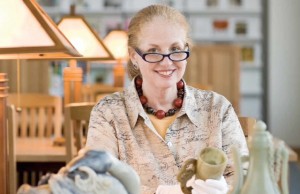It was in the spring of 2011, I believe, when the Indianapolis Museum of Art announced that it had appointed two “curators-at-large” funded by a grant from the Mellon Foundation. The museum selected James Watt, who had stepped down from his position as Senior Curator in the Metropolitan’s Department of Asian Art, and Mahrukh Tarapor as the first two.
Now it has announced another: Amy Poster (below), Curator Emerita of Asian Art at the Brooklyn Museum as well as an independent curator and consultant specializing in South and East Asian art.
 For some strange reason, the museum is a little secretive about these posts. The press release announcing Poster says she began her work in July, 2012 — but it’s just announcing the appointment now. And it never mentioned Tarapor, who delayed her arrival in Indianapolis and then, last April, gave it up when the Museum of Fine Arts, Houston, appointed her senior advisor for international initiatives there.
For some strange reason, the museum is a little secretive about these posts. The press release announcing Poster says she began her work in July, 2012 — but it’s just announcing the appointment now. And it never mentioned Tarapor, who delayed her arrival in Indianapolis and then, last April, gave it up when the Museum of Fine Arts, Houston, appointed her senior advisor for international initiatives there.
If Indy is embarrassed, it shouldn’t be — these things happen and it’s no reflection on the museum, in my mind.
The question is, what are they doing?
Watt, who began his one-year term in November, 2011, has been quite busy on his visits. According to the press release, he
has analyzed the IMA’s Chinese ceramics, jade and most of the bronzes in storage and currently on display. As part of his work, Watt certified the dates and periods on several works of art, and in some cases corrected dates of the objects. Through additional research in Hong Kong, Watt hopes to concretely authenticate some works from the IMA’s ceramics collection that may prove to be older and more precious than previously believed. Additionally, Watt is assisting Teramoto in planning for the reinstallation of the IMA’s permanent Asian galleries, opening in 2014.
Kathryn Haigh, the museum’s deputy director for collections and exhibitions, also said that he plans to reinstall the Chinese objects thematically, thus highlighting “the history of porcelain making in China among other things.” And “James is currently researching a pair of chicken cups that may rival similar objects in the imperial collection, which is very exciting.â€
For her part, Poster will help develop a long-term collecting strategy for Indian and Southeast Asian art. She is also
studying the history of the IMA’s Lockwood de Forest wall. De Forest (1850-1932) was a partner of Louis Comfort Tiffany and was well known for establishing an Indian wood-working studio in Ahmedabad, Gujarat, which produced items for the American market from the late 19th to early 20th centuries. One of the earliest Asian artworks acquired by Museum, the wall was purchased by the Art Association of Indianapolis in 1915 (a precursor to the IMA) from Lockwood de Forest. The wall has been shown in multiple manifestations over the last century.
If this was a trial for Mellon, testing the idea for possible use elsewhere, it seems to me to be a good one. With budgets stretched, some museums can’t afford full time curators in each department they have — sharing curators, using independent curators, and tapping into year-long scholars, like these, will probably spread. Kudos to Mellon for this experiment.
Photo Credit: Courtesy of the Indianapolis Art MuseumÂ
